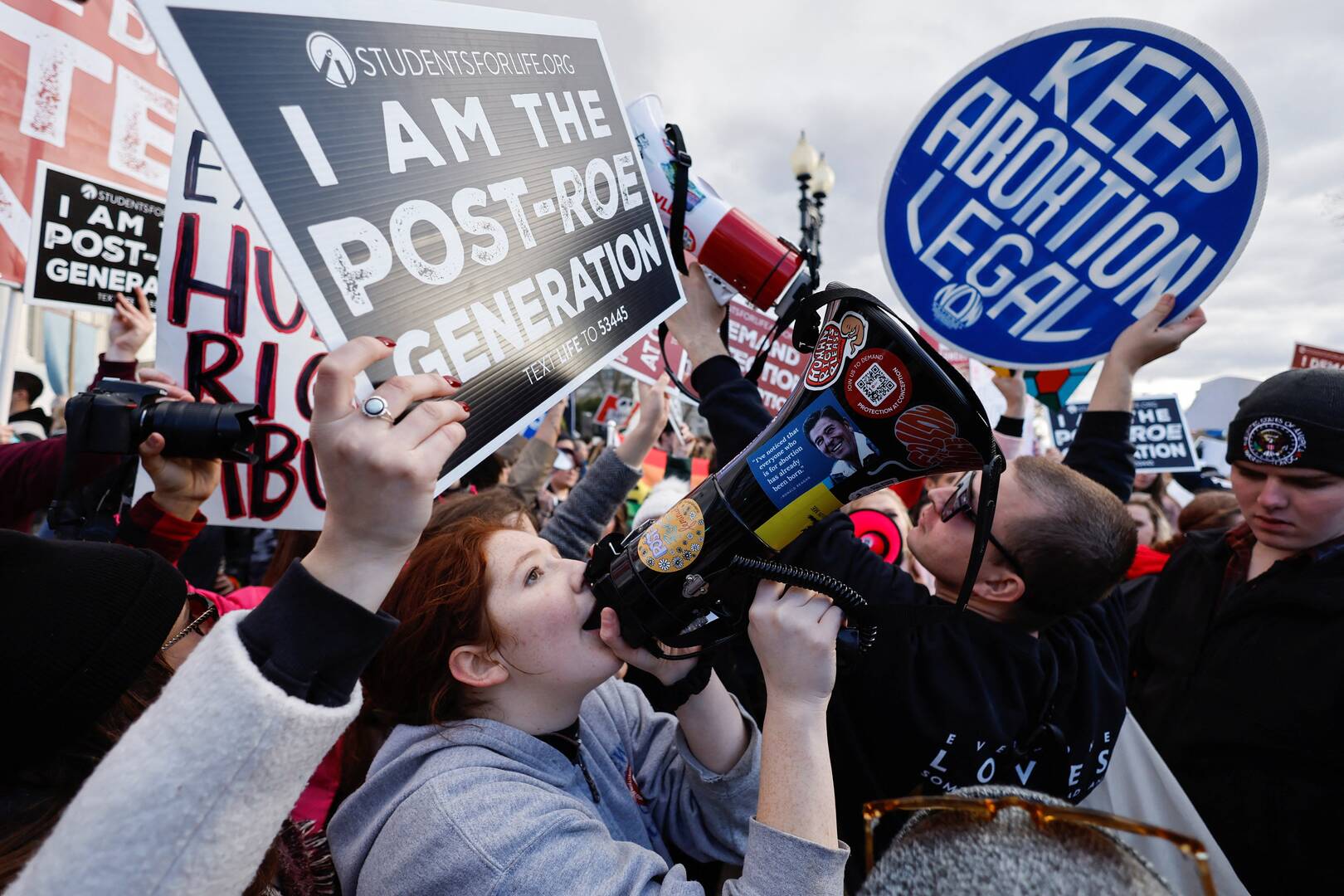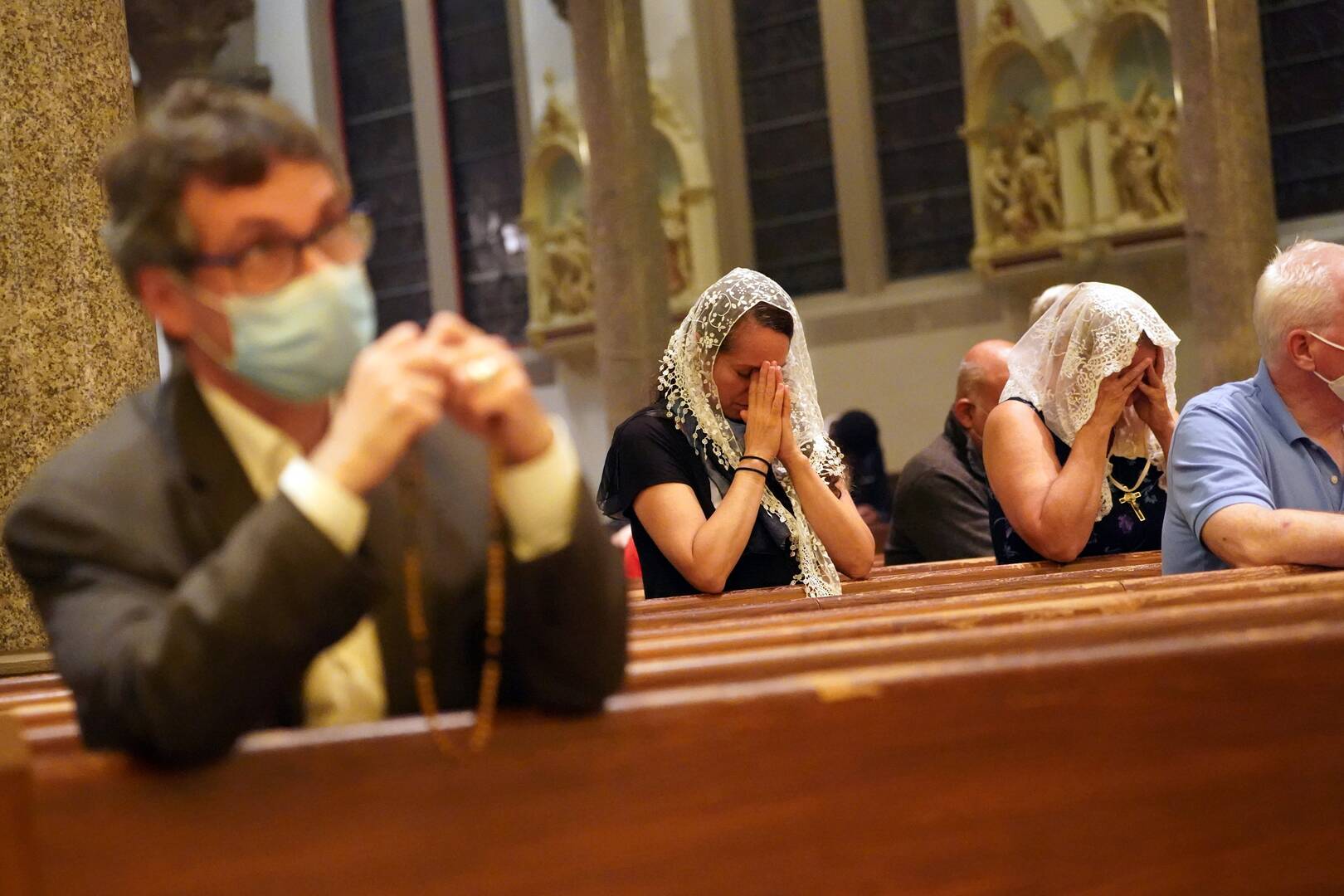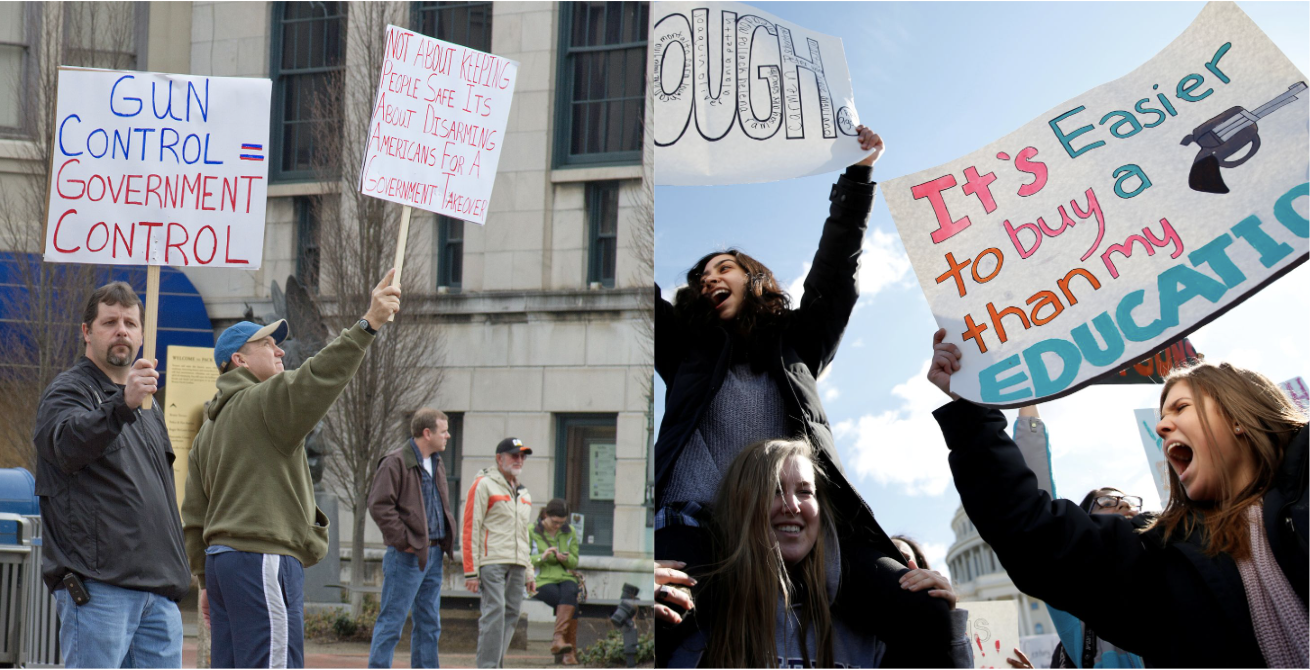Catholicism, authentic communion and the way out of our polarization trap
What is the way out of polarization? And why does that question—along with the now-commonplace observation that society suffers from deepening divisions about everything from gun control to abortion to public funding for religious schools—seem so exhausting?
Polarization is exhausting largely because it seems hopeless, and also because it gets progressively worse. Americans’ negative attitudes toward political parties other than their own, as measured in surveys, have increased dramatically in recent decades and at a much faster pace than in other countries.
These entrenched divisions simultaneously increase the vehemence of our arguments and decrease our willingness to listen to one another. We exhaust ourselves declaring our opinions, but we are not really in conversation. We produce monologues that are intended more to reassure us than to convince those with different views—or worse, that are received by them as taunts and provocations which must be answered in turn. Constant exposure to arguments that we are not willing or able to engage with in dialogue is draining as well. It is like listening to a radio tuned to a station that is half static, half shouting—but that we dare not turn off lest we miss the point our own monologue will aim to refute later.
When we think about polarization in terms of its derangement of public discourse, we often think first of political partisanship. But it is clear that this dynamic also plays out in many realms of common life, including religion. In the Catholic Church, it is easy to recognize polarization operating both within the life of the church itself and in the church’s relation to the secular world. For example, conflicts over the Traditional Latin Mass and over how the church should engage with a wider culture whose sexual norms have changed radically both reflect different factions arguing fervently but often talking past each other.
Indeed, what most characterizes polarization is the constant sense of threat: Everything is at stake all the time, always in need of defense.
In fact, a closer look at the relationship between religion and secularity provides powerful insights about how polarization arises and how it becomes so intractable—and it also helps us imagine how to find a way toward greater unity. The reality of the church as a communion, not just an association of individuals, offers a powerful antidote to polarization. Finding resources within the church’s tradition for a healthier engagement across internal divisions can provide a model for responding to secular forms of polarization as well. As I begin my service as America’s 15th editor in chief, I want to put the ministry of America Media at the service of these hopes.
Where Polarization and Secularity Intersect
Polarization is not simply an intense form of extremism; it is not just the worst case of division or disagreement. The kind of polarization that is exhausting us is, instead, a pathology endemic to pluralism. It is a name for how attempts to live together with others who hold different accounts of meaning, goodness and human nature—accounts that overlap and intersect but do not fully agree—break down and turn into fear and scapegoating instead. Our arguments about how to live together run in circles. As we despair of ever convincing each other, the “other side” in a polarized discourse becomes less a partner in conversation and more a threat to be neutralized.
Indeed, what most characterizes polarization is the constant sense of threat: Everything is at stake all the time, always in need of defense. Because we lack shared ground on which to agree or disagree, we also feel the lack of safe ground for our own beliefs. This is the ugly and dangerous truth of why the outrage machines of social media and the 24-hour news cycle work so well on us. We are already afraid—and they are ready at hand to tell us why.
Believers or not, we all live in a secular age, in which we become responsible for opting to believe.
In thinking through how polarization operates, I have found that the philosopher Charles Taylor’s analysis in A Secular Age offers crucial insights into how the stakes of disagreement have risen so high in our contemporary situation. (While I would encourage everyone interested in these issues to read A Secular Age themselves, a 900-page tome is a very good reason to make a recommendation of a shorter précis as well. James K. A. Smith’s How (Not) to Be Secular is an excellent exploration of the key points of Taylor’s work.)
There are two main points from Taylor that have bearing on the question of polarization: his distinction between three different meanings of secular and his concept of being “cross-pressured” by having to constantly choose among many sources of ultimate meaning.
Taylor argues that the meaning of the word secular has at least three different senses. First, secular can mark out a sphere differentiated from the sacred, as when the church is separated from the state. Second, it can describe the results of the historical process of secularization, such as a decline in belief in God or religious practice. But Taylor is not satisfied with the assumption that modernity or rationality necessarily leads to secularization and decline in belief. So the third sense of secular describes a cultural context in which religious belief has come to be understood as one contested option among others.
This means that Taylor’s third sense of secular applies even to those who are fervently religious and deeply converted. It names the condition in which answers to ultimate questions can no longer be taken for granted, even by those who take religion most seriously. Believers or not, we all live in a secular age, in which we become responsible for opting to believe.
The responsibility for choosing frameworks of understanding applies not only to questions of belief in God, but also to how we understand meaning itself and how we envision human nature and goodness.
Taylor’s third sense helps us see that the secular is not an automatic antagonist for religion. There is indeed a “secularism,” an ideological opposition to religion that assumes belief is destined to decline and is only too willing to hasten the process. But there is also a “secularity”—not an antagonist opposing religious belief, but a new context within which both religious belief and unbelief operate.
It is in this context of secularity, in which we have become self-consciously responsible for the choice either to believe or not to believe, that the stakes are raised. Taylor describes this situation as being “cross-pressured.” We are all conscious of being pulled toward both belief and unbelief. When we feel the attraction of the transcendent, we always have a rival explanation ready at hand that would not disrupt the disenchanted, immanent world we occupy: “Yes, that could be the voice of God. But it might also just be me talking to myself.”
We cannot escape the responsibility for choosing how and whether to pay attention to such longings and for choosing the framework within which to understand them. Nothing comes to us with its meaning built-in and uncontestable, because even the recognition that such robust meaning is possible is an option that has to be consciously embraced.
Taylor notes that what makes cross-pressure even more challenging is that it cannot be definitively relieved. Even after we choose belief or unbelief, we still feel the pressure of other options as possibilities for us. This pressure is not skepticism or even active doubt with regard to religious belief, but simply the fact that in secularity, belief cannot be settled once and for all. We have to opt in continuously to the project and practice of belief.

Taylor’s concept of cross-pressure helps to explain how polarization (and exhaustion with it) arises within pluralism. Secularism, as an ideological opponent of religion, tries to settle the question of belief by relegating experience of the transcendent to the private sphere, but this has the inevitable consequence of making responsibility for opting in to (or even out of) belief almost unbearably heavy to carry alone. Fundamental commitments cry out for shared responsibility; we need help with these burdens.
The responsibility for choosing frameworks of understanding applies not only to questions of belief in God, but also to how we understand meaning itself and how we envision human nature and goodness. Unless we learn to share the burden of continuously choosing these commitments—even and especially in situations where the answers are not universally agreed upon—cross-pressure becomes nearly overwhelming. And so instead of looking for ways to sustain and channel that pressure, we start to look for ways to vent and discharge it, all too often at the expense of an enemy on the “other side” of a contested choice for meaning.
Polarization Within the Life of the Church
Taylor’s analysis of cross-pressure and secularity provides a background for understanding how polarization is also a threat and challenge for the church, because Catholics believe and worship within the context of secularity and a plurality of frameworks for ultimate meaning. The Catholic Church is not pluralistic in the sense that it holds all religious viewpoints as equally true, nor should anyone expect or want it to be. The communion of the church binds Catholics together in one faith—not simply as an organizational principle of the church, but because no one can be a member of the body of Christ alone. Catholic faith is always an ecclesial faith, and the one church of Christ proposes a universal account of meaning, goodness, human nature and the relation of human beings to God.
While the church’s communion is universal, in order for it to be healthy under the conditions of secularity, it cannot imagine itself as a refuge from pluralism. The temptation is to treat the church as a space where believers should be safe from any confusion, secure on the ground of the church’s unchanging teaching. But this impulse misreads secularity as secularism, as the ideological opponent of religion rather than the context for both belief and unbelief. So it treats the unavoidable challenges of cross-pressure as antireligious assaults on faith, framing any difficulty in assenting to church teaching as a fundamental danger.
The church must form believers from, and for discipleship within, a world in which religious belief cannot be taken for granted and is always contested.
There is a reciprocal temptation to imagine the church as perfectly at home with pluralism, making no truly universal claims at all. In this temptation, the primacy of conscience can become a license to make one’s own decisions about belief in a solipsistic, one-way dialogue in which the tradition and church teaching might inform conscience but cannot easily make demands on it. But this falls prey to its own version of secularism’s error of relegating religious questions to the private sphere and reduces the church’s communion to a kind of consensus, consisting of nothing more than the sum of individual religious options.
Avoiding both these temptations, the church must form believers from, and for discipleship within, a world in which religious belief cannot be taken for granted and is always contested. But such formation is unsustainable unless it can be shared at a level deeper than merely personal choice and commitment. Both of these realities are operative in the church’s struggle with polarization.
Even though the conditions that produce polarization involve the struggle between belief and unbelief, they contribute to conflict in the internal life of the church as well. A brief look at Catholic conversation, especially online, will quickly demonstrate that many in the church are reflexively suspicious of other Catholics’ orthodoxy, reacting to any disagreement or even any different theological emphasis by subjecting others to an ad hoc inquisition for heresy.

An underlying good motive—to defend and explain the tradition of the church—is at least partially at work in many of these responses. However, in polarized conditions, this practice becomes distorted into hypervigilance against any hint of confusion. The goal is no longer explanation of teaching, but the preservation of the church as a safe space against the threat of secularism, which obscures the deeper challenges of discipleship within the context of secularity.
Once the stakes have been raised in this way, the conversation in which an explanation could be heard and understood never really begins. Rather than a dialogue that aims to help fellow Christians to change their minds, such interventions become a show of force explaining to those who already agree exactly how wrong the suspect position is. And it is equally easy for defensive responses to these ad hoc inquisitions to fall into the same pattern.
When America interviewed Pope Francis last November, I asked him about polarization, both in politics and the church, and he responded forcefully: “Polarization is not Catholic.” In the wake of polarization, Pope Francis said, “a divisive mentality arises, which privileges some and leaves others behind.” In contrast to polarization, he described the action of the Holy Spirit as “harmoniz[ing] opposing differences.”
The pope’s trust in this action of the Spirit is also at work in his commitment to synodal dialogue, even when it is messy and complex. And yet we have seen that the Synod on Synodality is itself a flashpoint for polarization in the life of the church and even in discussions among bishops. Some Catholics are suspicious that openness to dialogue and a call to listen to voices on the margins is a Trojan horse for plans to change doctrine. Other Catholics seem to presume that dialogue puts every kind of structural and theological reform on the table for discussion, regardless of whether or not it is compatible with tradition or if the church is ready for it, a tendency Francis has criticized strongly as “elitism” in his appraisal of the German Synodal Way.
The remedy for polarization in the life of the church cannot simply be better arguments, better apologetics or better catechesis. Such remedies only have a chance to work if they can be applied within a framework of dialogue based on mutual trust.
All of this means that Catholics engaged in public discourse about faith and the church—and I am certainly including both myself and readers of America in this category—need to examine their consciences to ask how deeply they hope in the work of the Holy Spirit harmonizing differences. As Sister Nathalie Becquart, X.M.C.J., said in a lecture on synodality (a version of which begins on Page 38 of this issue), “Harmony is preferable to monotony, but harmony can only be achieved via sharply different notes in combination.” When we go into conversation with other Catholics in areas where we disagree, are we seeking to add a note in combination or to make sure our note is the only one heard?
Can we recognize each other within the bonds of communion, or have we already decided in advance that a sister or brother is a threat to the truth and the common good rather than a fellow pilgrim searching for it? Are we ready to let our own ideas and desires be shaped and disciplined, both by the tradition of the church and by the needs of our sisters and brothers whose experience of faith is different from our own? Or are we so convinced we are right that we enter into conversation principally to demonstrate how others are wrong?
The remedy for polarization in the life of the church cannot simply be better arguments, better apologetics or better catechesis. Such remedies only have a chance to work if they can be applied within a framework of dialogue based on mutual trust. In an atmosphere of suspicion and divisiveness, these approaches can be twisted, even when they come with the best intentions, into strident reassurances for those who are already convinced of one position or another rather than charitable and generous engagement with those who think differently. And in those conditions, argument and explanation only deepen polarization and the exhaustion it causes.
Communion as a Way Out of Polarization
In response to polarization, many have noted the importance of civil discourse. While necessary, however, civility alone is not sufficient. The fuller remedy for polarization is the practice of communion. We need to learn and relearn that we are bound together in the life of the church at a level deeper than our own agreement. This unity, which arises from our common baptism, makes it possible to sustain the experience of being cross-pressured without succumbing to polarization and making enemies of one another.
Ironically, both the tendency for hypervigilance against heterodoxy and the tendency to treat doctrine as easily revisable suffer from reducing communion to a kind of social contract. For the latter, doctrine has only as much binding force as we are willing to grant it and can be revised again if our willingness to consent to it changes. For the former, any specter of change in teaching is tantamount to a crisis, the social contract demands full and unquestioning assent, and those who do not offer it must be aggressively quarantined lest the contagion spread.

But ecclesial communion is neither malleable according to our opinions nor so fragile as to collapse when the tradition is examined critically and the possibility of doctrinal development is recognized as a part of God’s ongoing preservation and guidance of the church in history. More importantly, communion is not a product of our consensus, but a cooperation in God’s grace as members of the body of Christ.
The reality of being in communion, in other words, does not cease when Catholics disagree with one another, nor do our obligations to one another as members of that communion. We are still members of the same body of Christ, called to the one table of the Mass—even when, as is often tragically the case, our approaches to the Mass itself are points of division and rancor.
When the dynamics of polarization take over, we start to treat other Catholics as enemies or even as traitors who are dangerous to the life of the church. Disagreement leads to suspicion that our interlocutor does not really believe in the same faith as we do. This is poisonous to charity, and because it destroys trust, it also works against any hope of helping brothers and sisters in Christ to grow in faith. Worse yet, these internal divisions in the church are ripe for exploitation by other forms of polarization, especially by partisan political divisions.
What is necessary for us to begin to find our way out of polarization is a deliberate practice of cultivating and valuing communion, especially in the midst of disagreement. Rather than demonstrating how another Catholic has betrayed or undermined the faith, we ought first to look for evidence, even in what we disagree with, of the faith we hold in common, and celebrate that evidence when we find it.
This idea is not my invention. It is simply an application of the “Presupposition” from the Spiritual Exercises of St. Ignatius of Loyola to the situation of polarization. In order that a retreatant and retreat director may be “of greater help and benefit to each other,” Ignatius counseled:
It should be presupposed that every good Christian ought to be more eager to put a good interpretation on a neighbor’s statement than to condemn it. Further, if one cannot interpret it favorably, one should ask how the other means it. If that meaning is wrong, one should correct the person with love; and if this is not enough, one should search out every appropriate means through which, by understanding the statement in a good way, it may be saved.
It is striking how much effort and desire Ignatius calls for. We are to be “more eager” to find a good interpretation than a bad one and to ask how to interpret what we cannot readily accept. If that does not succeed, we should correct “with love” and “if this is not enough”—having already made the previous three attempts to reach agreement—we are to “search out every appropriate means” to save the statement we are tempted to condemn. Disagreement and condemnation among Christians are envisioned more as a failure of love than as a principled defense of the truth against a subversive enemy.
Even in disagreement, we Catholics will acknowledge one another as seeking the communion we already share whenever possible; we will not hasten to predict or threaten its failure.
Ignatius’ advice might be rejected as idealistic, or perhaps criticized for having as much potential to be exhausting as does the very polarization that it might help us avoid. But this is precisely the effort that is necessary to sustain communion in a cross-pressured and polarized world. And it is also the kind of effort necessary for a new evangelization in the context of pluralism and secularity where all claims to ultimate meaning are contestable and even devout believers need help and community to keep opting in to the possibility of faith.
At its best, the way of seeing recommended by the “Presupposition” involves an enlargement of our own imagination of another’s motives. We are asked to see how they might be trying to say something we can agree with, even when we cannot agree with what they have actually said. To put it somewhat more theologically, we are asked to see—and to want to see—how something we are inclined to reject might proceed from a desire for the good, and a desire for God, in which we already share.
This is a deeply hopeful vision, and it is one America will try to put into practice.
Communion reveals that polarization is not an automatic consequence of difference and exposes it as a lie that deceives us into fearing each other instead of recognizing what we hold in common.
We commit ourselves—and we will exhort our contributors—to both imagine and acknowledge the best motives of those with whom we may disagree, especially within the life of the church. This does not mean we will manufacture agreement where it does not exist; nor does it mean forgoing any possibility of correction as sometimes necessary to maintain the bonds of communion. But it does mean that we believe that such critique is more likely to succeed in its goals and to help fellow believers if it is animated by a vibrant charity, more eager to recognize and celebrate a shared faith than to find something in need of correction.
Catholics will still disagree with one another, and they will disagree in the pages of America. But even in disagreement, we will acknowledge one another as seeking the communion we already share whenever possible; we will not hasten to predict or threaten its failure.
In 1909, our founding editorial announcement promised that America would “be cosmopolitan not only in contents but also in spirit. It will aim at becoming a representative exponent of Catholic thought and activity without bias or plea for special persons or parties.” That promise, in today’s context of secularity and the all-too-easy collapse of disagreement into polarization, is what motivates this commitment to the practice and cultivation of communion.
Sam Sawyer, S.J., is the editor in chief of America Media.


No comments:
Post a Comment